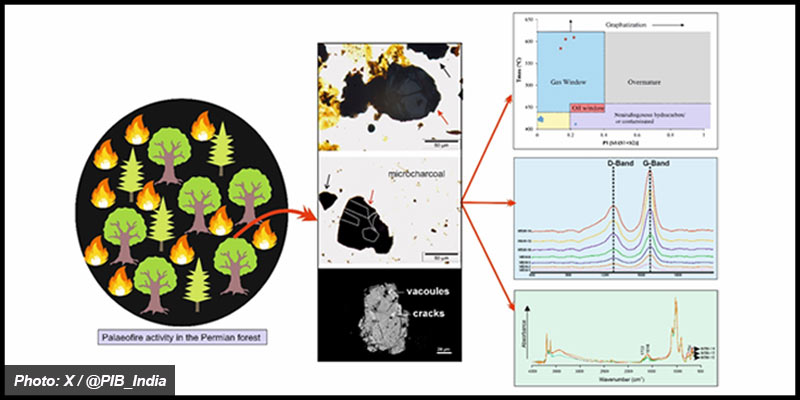- India
- May 07
- Sreesha V.M
Scientists unearth new insights into wildfires during Permian period
• A team of Indian researchers has made a groundbreaking discovery about ancient wildfires that occurred during the Permian period, approximately 250 million years ago.
• The study, conducted by scientists from the Birbal Sahni Institute of Palaeosciences (BSIP) in Lucknow, provides new insights into how these pre-historic fires shaped Earth's geological and climatic history.
• Published in the prestigious journal ACS Omega, the research marks a significant advancement in our understanding of palaeofires and their environmental impact.
• From the Late Silurian (spanning from 419.2 to 443.8 million years ago (mya) to the Quaternary (2.58 mya) period, palaeofires left their mark on landscapes, influencing vegetation, climate, and even the formation of coal.
• Scientists had long observed macroscopic charcoal in Permian coal-bearing formations across Gondwana, hinting at widespread wildfires. • The Raniganj Coalfield in India was among the first sites where fossil charcoal was identified, revealing a connection between palaeofire systems and seasonal drought-induced fires.
• The investigation focused on shale samples collected from the Godavari Basin in peninsular India. Using cutting-edge analytical techniques including Raman Spectroscopy, Rock-Eval Pyrolysis, and FTIR Spectroscopy, the research team was able to distinguish between charcoal formed by local fires and charcoal that had been transported by wind or water.
• This breakthrough solves a long-standing challenge in palaeofire research, where scientists previously struggled to determine whether charcoal deposits represented in situ burns or transported remnants.
• The study reveals fascinating details about the relationship between ancient wildfires and environmental conditions during the Permian period.
• The researchers found that periods of falling sea levels (regressive phases) preserved clear fire signatures, while rising sea levels (transgressive phases) resulted in more mixed and oxidised charcoal deposits.
• These findings suggest that climate and sea level changes significantly influenced how wildfire evidence was preserved in the geological record.
• Beyond its historical significance, the research has important implications for modern climate science.
• The team’s analysis of how organic matter transforms during palaeofires provides valuable insights into long-term carbon storage processes.
• This knowledge could prove crucial for developing effective carbon sequestration strategies to combat contemporary climate change.
• The study also enhances our understanding of coal formation and the role wildfires played in shaping ancient ecosystems.
• These findings provide scientists with a more precise toolkit for interpreting past fire events, vegetation changes, and carbon cycles. The study not only advances the knowledge of Earth’s fiery history but also demonstrates India’s growing role in cutting-edge paleoenvironmental research.
• As scientists continue to decode these ancient climate records, such discoveries help bridge the gap between pre-historic environmental conditions and our modern climate challenges.
(The author is a trainer for Civil Services aspirants.)

